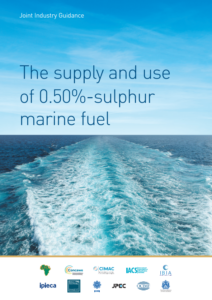A number of shipping, refining, fuel supply and standards organisations have collaborated in order to produce Joint Industry Guidance on the supply and use of 0.50% sulphur marine fuel released on 20 August 2019.
In October 2016, the International Maritime Organization (IMO) established a global limit for sulphur in fuel oil used on board ships of 0.50% m/m to apply from 1 January 2020. The implementation of this regulation is expected to have significant implications throughout the marine fuel supply chain, and will require detailed consideration by all parties associated with the production, distribution, storage, handling and use of these fuels. For this reason, a Joint Industry Project (JIP) has been established to raise awareness of these issues.
[smlsubform prepend=”GET THE SAFETY4SEA IN YOUR INBOX!” showname=false emailtxt=”” emailholder=”Enter your email address” showsubmit=true submittxt=”Submit” jsthanks=false thankyou=”Thank you for subscribing to our mailing list”]
This document is one of the results of the JIP, and it provides guidance on the technical and safety implications of the new requirement for max. 0.50%-sulphur fuels. It can be applied to personnel involved in the marine fuels and shipping industries, from fuel blenders and suppliers through to end users.
What is more, it provides a background to the MARPOL Annex VI regulation as it impacts the change to a new marine fuel regime, and addresses issues such as fuel compatibility, fuel stability, and fuel handling and storage, together with the operational factors that can affect safety.
In addition, it frequently addresses IMO, CIMAC and ISO documents which should be consulted as necessary. Moreover, the partners to the JIP are using this guidance as the basis for developing an e-learning course module for relevant stakeholders.
The e-learning course will be released in October 2019, aiming to:
- Provide an understanding of MARPOL Annex VI and its potential impact on the management of fuels on board ships;
- Raise awareness of and offer solutions to potential fuel management issues.
The publication contains various important messages, which can be summarized as following:
- Ensure fuel quality by ensuring that blend components are suitable for bunker fuel production, with particular attention being given to ensure that the final product is stable.
Fuel suppliers and purchasers should provide adequate information to the ship concerning the fuel as supplied to enable ship crew to identify and manage potential safety and operational issues associated with certain fuel properties and characteristics; - Fuel characteristics are expected to vary considerably between bunkers. The ship’s crew will need to adopt a more proactive approach to fuel management. They will need to know the fuel characteristics as loaded and be able to respond to the requirements, especially in terms of on board temperature requirements and any commingling;
- While compatibility between fuels from different supply sources can be a concern in today’s environment, assessing compatibility of 0.50%-sulphur fuels from different sources will be key. To the extent possible, fuel should be loaded into an empty tank. The available space for new bunkers to be loaded should be taken as the capacity of the empty tanks in order to avoid commingling on loading;
- Ship operators and fuel suppliers should review operational practices to allow sufficient time to test for compatibility between existing and proposed bunker fuel delivery, especially if no “empty” dedicated storage tank is available on the ship.
However, it must be noted that it does not discuss compliance with Flag State, Port State or IMO rules or guidelines, or alternative means of compliance (such as scrubbers), and does not include a discussion of other fuels, like liquefied natural gas, hydrogen, methanol, etc.
The publication has been developed by several actors across shipping, refining, supply and testing of marine fuels, which are the following:
- African Refiners Association;
- Concawe, Environmental Science for European Refining;
- Institute of Marine Engineering, Science & Technology;
- International Association of Classification Societies;
- International Bunker Industry Association;
- International Council on Combustion Engines;
- International Union of Marine Insurance;
- IPIECA (The global oil and gas association for advancing environmental and social performance);
- Japan Petroleum Energy Center;
- Oil Companies International Marine Forum;
- The Royal Institution of Naval Architects.
Ensuring correct use of the new fuel
The guidance presents a comprehensive set of responsibilities, that several actors across the shipping industry have and must adhere to. More specifically:
Responsibilities of fuel suppliers
Suppliers are expected to deliver a fuel which meets the parameters agreed between the supplier and the buyer. The fuel supplier is the party responsible for the delivered quantity and quality either directly or through subcontractors. Likewise, ‘meeting the needs of the ship’ means that the fuel supplied should be stable in regular handling, homogeneous across the entire delivery and fit for purpose after appropriate on-board treatment.
The supplier is also responsible for maintaining appropriate documentation to help identify product origins, including the manufacturing source and the various links in the supply chain, to allow traceability. Monitoring fuel quality at each step of the supply chain will also be crucial to identify points of entry of any extraneous or harmful materials if these are discovered when the fuel is being used. If suppliers get components from other suppliers, they should obtain assurance that appropriate supply chain quality control steps have been taken.
It is important that the supplier delivers accurate information so that the ship operator can characterize the fuel supplied and take the appropriate initial steps in setting up procedures for the handling, treatment and use of that fuel
the guidance highlights.
This information would be added to the required provision of the representative commercial samples, MARPOL delivered sample, material safety data sheets (MSDS) and bunker delivery notes (BDNs). The additional information would be in the format of a comprehensive certificate of quality (CoQ) or equivalent documentation.
Quality control during production of bunkers
The bunker supplier should ensure control of individual blend component quality. This includes knowing the components’ individual properties through accurate data, and the component origins supported by relevant documentation as agreed between the buyer and seller of the components.
Blend components should also be of known suitability for bunker fuel production, with particular attention being given to ensure that the final product is stable.
The fuel should not include harmful or damaging materials in concentrations that may cause damage as defined in Clause 5 of ISO 8217:2017 and Regulation 18.3 of MARPOL Annex VI. This does not preclude the use of additives intended to improve specific fuel characteristics such as cold flow or combustion properties. Any additive used should have a proven track record and should be thoroughly evaluated to ensure that it is fit for use in marine fuel applications.
Furthermore, the supplier should ensure that the final blend, whether produced at a refinery or in a tank terminal, is tested at an accredited (e.g. ISO or equivalent certification) laboratory.
Transport, storage and transfer
The quality of a bunker fuel or blend components may change compared to its origin during transportation, transfers and storage. The supplier should oversee the transportation of the fuel, blend components and additives to make sure that product contamination does not take place in tanker ships, shore tanks, pipelines, road tankers or barges prior to delivery. The supplier is expected to have in place a QMS (ISO 9001 or equivalent) to monitor, manage and assess the quality of the products they are supplying throughout the above processes.
When arranging delivery, the supplier is expected to ensure that the product is supplied without cross-contamination from any other grade being supplied to the ship, or from any other material previously handled by the delivery facility. This is especially important where delivery facilities are used to supply different grades of fuel and/or different sulphur specifications.
Delivery
If over one grade of bunker fuel is to be supplied, the order in which the grades are supplied should be agreed between the supplier’s representative and the ship’s master or officer in charge of the bunker operation. To prevent contamination of product during delivery, the report suggests that the lighter/lowest sulphur grade is supplied first, followed by the heavier/higher sulphur grade.
Where necessary, segregated pipelines/hoses and bunker connections for supply of materially different types of product should be provided, and for high and low-sulphur bunkers, to avoid cross-contamination of products. The use of multiple bunker barges or other delivery facilities to discharge a single product in ‘series’ adds complexity to the delivery and will require additional management and oversight. For this reason, such operations should be avoided to the greatest extent possible.
Sampling
Representative samples should be drawn during the bunker delivery for retention by both the receiving ship and the supplier, in addition to the MARPOL delivered sample which is a statutory requirement. The sampling process should be witnessed by representatives for both the supplier and the receiving ship. The sample containers should then be sealed at least once (and countersealed if requested by the receiving ship) with tamper-evident seals that have a unique means of identification, They should also be labelled, signed and countersigned by representatives of both parties.
Sampling should take place at each point of product custody transfer throughout the supply chain. The supplier should retain the bunker transfer samples for at least 30 days. If a dispute regarding the fuel quality occurs, samples should be kept until the dispute has been resolved. The above should be documented in the supplier’s QMS. This is a key part of a QMS, as it enables transparency and traceability, and helps the supplier identifyi the origin of potential problems and taking steps to remedy and prevent further quality issues.
It should be recognized that, in many ports, the contractual barge loading sample is often taken from the shore tank and not at a subsequent custody transfer point
the report explains.
Responsibilities of fuel users
Fuel purchasers are expected to order fuel of a quality or grade suitable for the receiving ship, taking into consideration its intended trading area as well as the capabilities of the ship to receive, store, handle and use the fuel, including the ability to segregate different batches of fuel to safeguard against incompatibility issues. The fuel purchaser and the end user (the ship) should take note of the following:
- On-board fuel management is an essential element of preventing operational issues. Improper handling of fuel on board may lead to non-compliance with MARPOL requirements on fuel quality and safety, even if the fuel received was compliant;
- Once fuel is delivered on board, ships should have documented procedures for the safe handling and use of the fuel. These procedures should form part of the company’s Safety Management System (SMS) which should be in place as a measure of good practice and/or as required by the International Safety Management (ISM) Code, as applicable, supported by equipment operating and maintenance manuals;
- Each ship should have in place fuel switching procedures (where applicable). The ship’s crew should be familiar with implementing these procedures;
- Marine fuel which fully meets statutory requirements and purchase specifications such as ISO 8217:2017, will nevertheless still require treatment before it meets most engine manufacturers’ requirements;
- Where a ship is exempted from some of the provisions of MARPOL Annex VI under Regulation 3 of the Annex, or will comply with the requirements of the Convention using an equivalent means of compliance under Regulation 4 of the Annex, fuel oil purchasers should consider any conditions attached to the exemption or equivalent means which may affect fuel purchasing.
Explore more in the PDF herebelow


































































